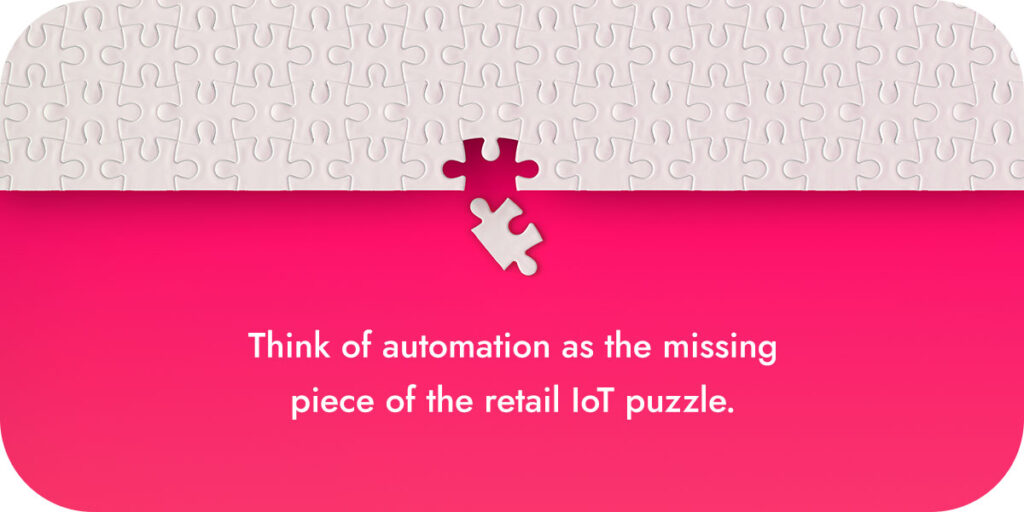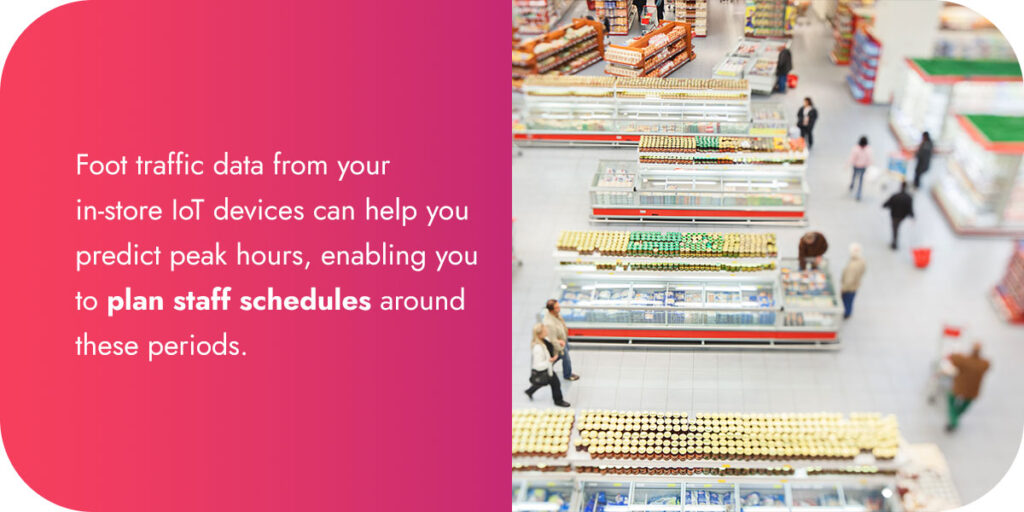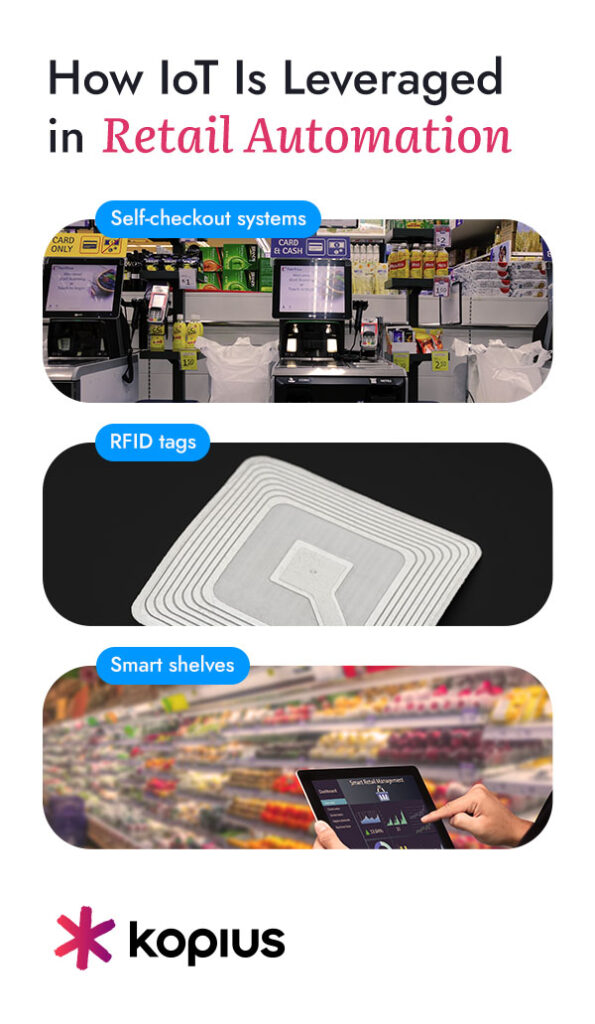
While technologies like the Internet of Things (IoT), artificial intelligence (AI), and automated tools have become mainstream in many industries, they’re only just emerging into the retail space.
Investing in an integrated retail and automation solution now can help you launch your business ahead of the competition and build your reputation as a thought leader.
Introduction to IoT in Retail Automation
Before diving into the details of IoT and retail automation, it’s important to understand how these technologies work together to create a comprehensive retail system.
In retail, the term “IoT” refers to the network of internet-connected devices in your stores and throughout your supply chain that collect, analyze, and report on business data. Some essential data you can track with retail IoT include:
- Customer behaviors: Sensors and cameras equipped with video analytics capabilities can reveal how customers typically move through the store, which displays they pay the most attention to, and where your customer service could improve.
- Inventory movement: Tagged inventory sends continuous signals to your inventory management system, updating inventory levels in real time for rapid replenishment and insights into customer preferences.
- Ambient conditions: Temperature and motion sensors can determine when people are most likely to be shopping, allowing these devices to automatically adjust the environmental conditions when more people are present.
IoT technologies allow you to complete your digital transformation by connecting the digital side of your company to the physical world. In other words, your IoT devices measure data from your real-world storefront and then input that information into a digital solution for analysis and reporting. These insights make it easy to identify areas for improvement, such as customer service personalization and supply chain optimization.
Types of IoT Devices Used in Retail
IoT systems can be either simple or highly complex, depending on their scale and the diversity of technologies you use.
Some of the most commonly used IoT retail devices include:
- RFID tags: Radio frequency identification (RFID) tags continuously transmit location data via radio waves, which allows you to track stock movement in real time.
- Sensors: Sensing devices monitor in-store conditions like foot traffic, lighting levels, temperature, and more to help you enhance the shopping experience and improve your energy efficiency.
- Cameras: You can use video analytics technologies to see how customers move through your store, which is valuable data for improving store layout. Real-time video analytics can also enhance store security by enabling you to catch criminal activity like theft in video feeds, streamlining investigations and preventing repeat offenders.
- Beacons: These Bluetooth devices sense when customers are nearby and automatically trigger preset actions relevant to each person. For example, a beacon could automatically award loyalty program members points every time they set foot in one of your stores.
Different stores will need different arrangements of devices, so it can help to work with a team of expert retail tech consultants to determine your specific requirements.
What Role Does IoT Play in Retail Automation?

IoT is transforming the industry as we know it, but how does it connect to automation in retail? Think of automation as the missing piece of the retail IoT puzzle.
Automated technologies enable seamless communication and trigger specific actions between each of your IoT devices, creating a complete system that operates with only minimal human intervention.
For example, a smart shelf can automatically update stock levels in your inventory management system. The software solution can automatically request a replenishment once those levels hit a predetermined point.
Core Components of IoT in Retail
Although every system is different in its individual configuration, most contain the same parts. The core components of a retail IoT solution include:
1. Smart Inventory Management
When combined with a cloud-based inventory management solution, your IoT network can help you keep better track of inventory levels to prevent issues from interfering with the customer experience.
Here’s how:
- Enhanced visibility: With the ability to track the whereabouts of each item in real time, you can minimize your potential losses by proactively mitigating issues like overstocking and stockouts across all your locations.
- Replenishment and demand planning: Real-time visibility into inventory levels through weight sensors and smart shelves enables automated systems to recognize when you’re getting low and prompt an immediate replenishment order, optimizing inventory levels based on current demand.
- Reduced risk of theft: RFID tags make it harder for shoplifters to steal from stores by alerting employees when unpurchased items cross a certain threshold. Additionally, retailers can use data from incidents to identify opportunities to tighten security.
2. Supply Chain Optimization
Supply chain disruptions can have serious consequences for retail companies. Retail IoT technologies and real-time analytics allow you to take a proactive approach to supply chain issues, saving you valuable time and money.
Some ways IoT helps optimize the supply chain include:
- Shorter lead times: The ability to receive real-time inventory updates enables greater business agility and efficiency, allowing you to pivot as soon as issues arise.
- Environmental monitoring: Sensors can track ambient conditions in warehouses and transport vehicles to ensure perishable and other delicate products meet quality standards when they arrive.
- Demand responsiveness: Insights into fluctuating customer demand enable companies to quickly adapt, which helps ensure the right products are available at the right times.
- Streamlined collaboration: When all your supply chain partners have total visibility into your inventory and demand forecasting data, they can use that information to better coordinate production, warehousing, and logistics.
3. In-Store Analytics for Enhanced Customer Support
IoT devices collect a lot of data, but you need to be able to use that data to make any real change. That’s where in-store analytics solutions come in.
Here are some ways IoT and data analytics solutions can help improve the in-person shopping experience:

- Staffing: Foot traffic data from your in-store IoT devices can help you predict peak hours, enabling you to plan staff schedules around these periods.
- Personalized service: In-store analytics help you understand typical customer needs and preferences, which can make it easier to meet specific customers where they are on an individual level rather than as part of a segment.
- Optimizing floor layout: Analytics can reveal how customers typically move around a store, enabling retailers to determine how to arrange products and displays in a way that helps customers find what they’re looking for faster.
The Impact of IoT on Retail Strategies
While IoT and retail automation are still emerging technologies, they’ve made a large impact on the industry. Here are some of the most important applications to pay attention to when considering the use of IoT.
Omnichannel Retailing and IoT
Omnichannel retailing has become a big deal in the past few years, and for good reason — creating a consistent experience across all your sales and marketing channels delivers a convenient, satisfying experience for customers. From one channel to the next, shopping or interacting with your brand is seamless.
This level of service is only possible because of IoT, which bridges the gap between your online and physical stores. The customer data you collect through your in-store IoT devices, as well as through your e-commerce and social media channels, provides valuable insight into what customers want from interactions with your brand. When you know what customers want, you can apply those changes across all your channels for a cohesive brand experience.
Personalized Marketing Strategies
According to one global study, 80% of consumers say they like receiving personalized product recommendations from brands. Brands that fail to deliver personalized service often lose customers because the experience lacks an emotional connection and is often less convenient.
But for many customers, the expectation of personalization has only risen. Hyper-personalization goes beyond traditional personalized marketing strategies by using advanced technologies like AI and IoT to collect and analyze individual customer data in real time.
So, rather than simply changing the name of the recipient in your marketing emails, you can reach each customer on an individual level. Automated retail software solutions let you apply hyper-personalization on a massive scale through digital channels, enticing more customers to visit your stores.
Understanding Automation in the Retail Industry
Automation and IoT technologies go hand in hand — you can’t have one without the other. Many automated solutions connect to IoT devices, which creates a seamless transfer of data and action across your entire store.
Automated Retail Technologies and Their Applications
Some of the ways retailers are incorporating IoT and retail automation into the shopping experience include:

- Self-checkout systems: One of the most popular examples of retail automation is the self-checkout, which enables customers to quickly pay for their items and leave. Self-checkout lanes now make up about 38% of all checkout aisles at grocery stores, with their heaviest users being shoppers aged 19 to 24.
- RFID tags: RFID tags are essentially smart labels that use radio frequency to track product movement and communicate it to other components in the system. You can use them to ensure you have enough product on the floor and help customers find what they need easier.
- Smart shelves: By using a network of connected RFID tags, digital displays, and IoT sensors, smart shelves can detect the location of items and communicate that information to you. This data can help you identify trends in consumer behaviors and preferences, which is essential for optimizing marketing and store layout.
Store Automation Solutions
Even a basic level of in-store automation is now essential for a retail company’s success, but why? The benefits of implementing these solutions include:
- Reduced costs: Higher efficiency means your staff can do more faster, and in retail, that means they can deliver excellent service to more customers. This combination can help you reduce costs associated with returns, human error, and reputational damage while also boosting your profitability.
- Operational efficiency: Automation augments your human staff by streamlining their workflows and taking the burden of repetitive tasks off their hands, which empowers them to tackle more valuable work in less time.
- Easier scalability: Automating routine processes reduces your hiring needs by boosting your human employees’ productivity, which provides more flexibility for expanding your business in the future.
- Better customer service: Automated solutions can take care of tasks that eat up store employees’ time, which allows them to focus all their attention on helping customers on the floor.
Navigating the Latest Retail IoT Trends
According to market projections, the global IoT market is expected to grow at a compound annual growth rate of 29.3% over the rest of the decade. The retail IoT market is especially suited for positive growth, with excellent potential for innovation and high activity in merger and acquisition.
Much of this growth is due to the rapid advancements in technologies like:
- AI: AI-powered analytics solutions can identify patterns like humans, which enables them to generate valuable insights into your company’s historical data. You can use these insights to inform your inventory and store management decisions for greater efficiency and better customer service.
- Machine learning (ML): ML is a branch of AI that enables AI algorithms to continuously learn from previous interactions, which means the recommendations and actions your program delivers will become more relevant to your business and your customers.
- Blockchain: This technology enables transparent data sharing through a series of linked blocks, which cannot be edited after completion. Some companies are incorporating blockchain into their shipping and fulfillment operations to enhance accountability and trust with business partners.
Preparing for the Future of Automation in Retail
Future-proofing your organization with advanced automated solutions is essential for gaining a competitive edge. One of the biggest challenges every company will face in implementing retail automation is setting up the proper infrastructure for the system:
- A strong, stable internet connection
- A robust, centralized cloud database to store and analyze IoT data
- Wireless or Bluetooth connectivity between all IoT devices
Companies also need to ensure their employees receive the proper training to use these technologies to enhance their everyday work. You’ll have to carefully consider what support mechanisms you can provide to assist your staff in troubleshooting any issues that pop up.
Kopius’s Approach to Retail Automation Solutions
Retail tech is complex, with many moving parts that need careful planning and attention to ensure they work properly.
If you’re unsure where to start, Kopius can help. We take a collaborative approach to retail tech, which enables us to deliver unparalleled results for retailers of various sizes and sectors.
Our team of experts will work closely with you and your people to understand your specific pain points, goals, and expectations. We’ll then design a custom solution tailored to your business that takes into account all existing physical and digital infrastructure.
Want to learn more about the companies we’ve helped? Read our case studies to see real examples of our work.

Begin Your Retail Tech Journey With Help From Kopius
IoT and retail automation present exciting opportunities for companies that invest in the proper infrastructure and support. That’s why we’re here.
When you take advantage of our JumpStart program, you gain access to our emerging tech team’s knowledge and expertise, which will help you spark innovations and strategize new projects that support your business goals.
What’s more, your solutions are tailored to your business — no matter how complex the specifications, we can create a custom retail analytics project that meets your organization’s unique requirements.
Are you ready to get started? We are, too. Contact us today to set up a consultation with our experts.
Related Services: